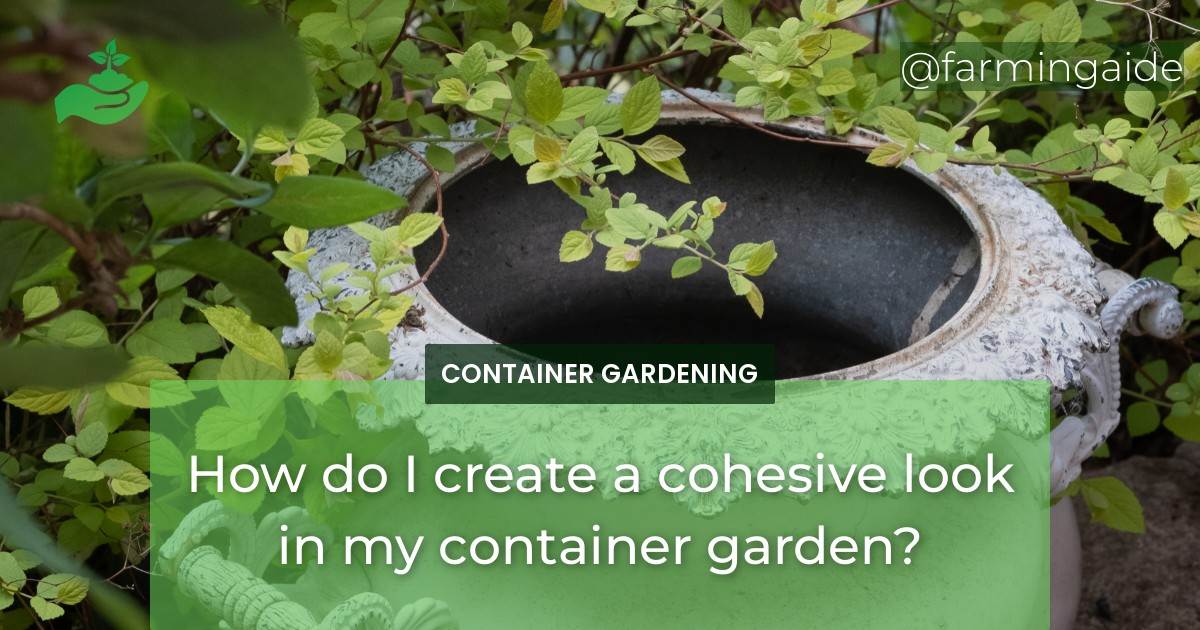Creating a cohesive look in your container garden is an important aspect of garden design. Container gardens are a great way to add color and texture to any space, and with the right design, they can be an attractive focal point in your landscape. A cohesive container garden design is one that looks intentional and harmonious, rather than a hodge-podge of different plants and containers. Achieving this look requires careful consideration of container selection, plant selection, and arrangement.
Understanding the Importance of Cohesiveness in Container Garden Design
A cohesive container garden design enhances the overall look and feel of your landscape. A well-designed container garden adds visual interest and can be used to create focal points in areas that lack architectural interest, increasing the value and appeal of your property.
Choosing the Right Containers for a Cohesive Look
Consider the Material of the Container
The material of your container can have a big impact on the overall look of your container garden. Consider the style of your home and landscape when selecting containers. Terracotta, concrete, and stone containers look great in traditional landscapes, while modern landscapes may benefit from sleek metal or ceramic containers. Wicker, wood, and plastic containers can be used in a variety of landscape styles.
Think about the Size of the Container
When selecting containers for your garden, consider the size of the plants you will be using. Larger plants require larger containers to grow and thrive, while smaller plants may get lost in oversized containers. A good rule of thumb is to select a container that is one and a half times the size of the plant’s root ball.
Choosing the Right Color and Shape of Container
Color and shape are important considerations when selecting containers for your garden. Consider the colors of the plants you will be using and select a container that complements or contrasts with those colors. The shape of the container can also enhance the overall look of your garden. Taller containers work well for plants with vertical growth habits, while wider containers are great for plants with sprawling growth habits.
ALSO READ
Selecting Plants for a Cohesive Container Garden Design
Choosing Plants with Similar Growth Habits
When selecting plants for your container garden, consider their growth habits. Plants with similar growth habits will look more cohesive when planted together. For example, plants with trailing growth habits like petunias and lobelia look great when planted with other trailing plants like sweet potato vine and verbena.
Considering Foliage Texture and Color
The foliage of your plants is just as important as their flowers when it comes to creating a cohesive container garden design. Consider the texture and color of your plants’ foliage and select plants that complement or contrast with each other. Plants with fine, delicate foliage like ferns and grasses look great when paired with plants that have bold, broad leaves like hostas and heucheras.
Incorporating Contrasting Shapes and Colors
Contrasting shapes and colors can be used to create interest and depth in your container garden. Use plants with contrasting leaf shapes and textures to create visual interest. For example, pair plants with spiky leaves like yucca with plants that have round leaves like coleus. Use contrasting colors to create a pop of color in your garden. For example, pair purple petunias with yellow marigolds for a bold, eye-catching display.
Arranging Plants to Create a Cohesive Look in Container Garden Design
Using the Thriller, Filler, and Spiller Technique
The thriller, filler, and spiller technique is a popular container garden design technique that helps create a cohesive look in your garden. The “thriller” is a tall, eye-catching plant that serves as the centerpiece of your container. The “filler” is a medium-sized plant that fills in around the thriller. The “spiller” is a trailing plant that spills over the edge of your container, softening the edges and adding a touch of whimsy to your design.
Arranging Plants in a Symmetrical or Asymmetrical Design
Symmetrical designs are balanced and formal, while asymmetrical designs are more relaxed and informal. Choose a design that complements your personal style and the style of your home and landscape. Symmetrical designs work well in traditional landscapes, while asymmetrical designs are great for more modern landscapes.
Balancing Height and Width in Container Garden Arrangement
When arranging plants in your container garden, pay attention to the height and width of your plants. Taller plants should be placed in the center or back of your container, while shorter plants should be placed around the edges. Use plants with different growth habits to create a visually interesting display.
ALSO READ
Maintaining Cohesive Container Garden Design
Regularly Pruning and Deadheading Plants
Regular pruning and deadheading will keep your container garden looking neat and tidy. Remove spent flowers and prune back leggy growth to encourage fuller, bushier plants.
Monitoring and Controlling Pests and Diseases
Inspect your plants regularly for signs of pests and diseases. Early detection and treatment can prevent the spread of pests and diseases and keep your container garden looking healthy and beautiful.
Consistently Watering and Fertilizing Plants
Consistent watering and fertilizing is essential for keeping your container garden healthy and thriving. Water your plants regularly and fertilize them according to their specific needs.
Can Adding Color and Texture Help Create a Cohesive Look in My Container Garden?
When it comes to creating a cohesive look in your container garden, incorporating color and texture is essential. By selecting plants with varying hues and different leaf shapes, you can add visual interest and harmony to your outdoor space. Experiment with different combinations to find the perfect balance for your garden.
Conclusion
Creating a cohesive look in your container garden requires careful consideration of container selection, plant selection, and arrangement. By following these tips, you can create a beautiful, harmonious container garden that adds visual interest and appeal to your landscape.
RELATED ARTICLES:


